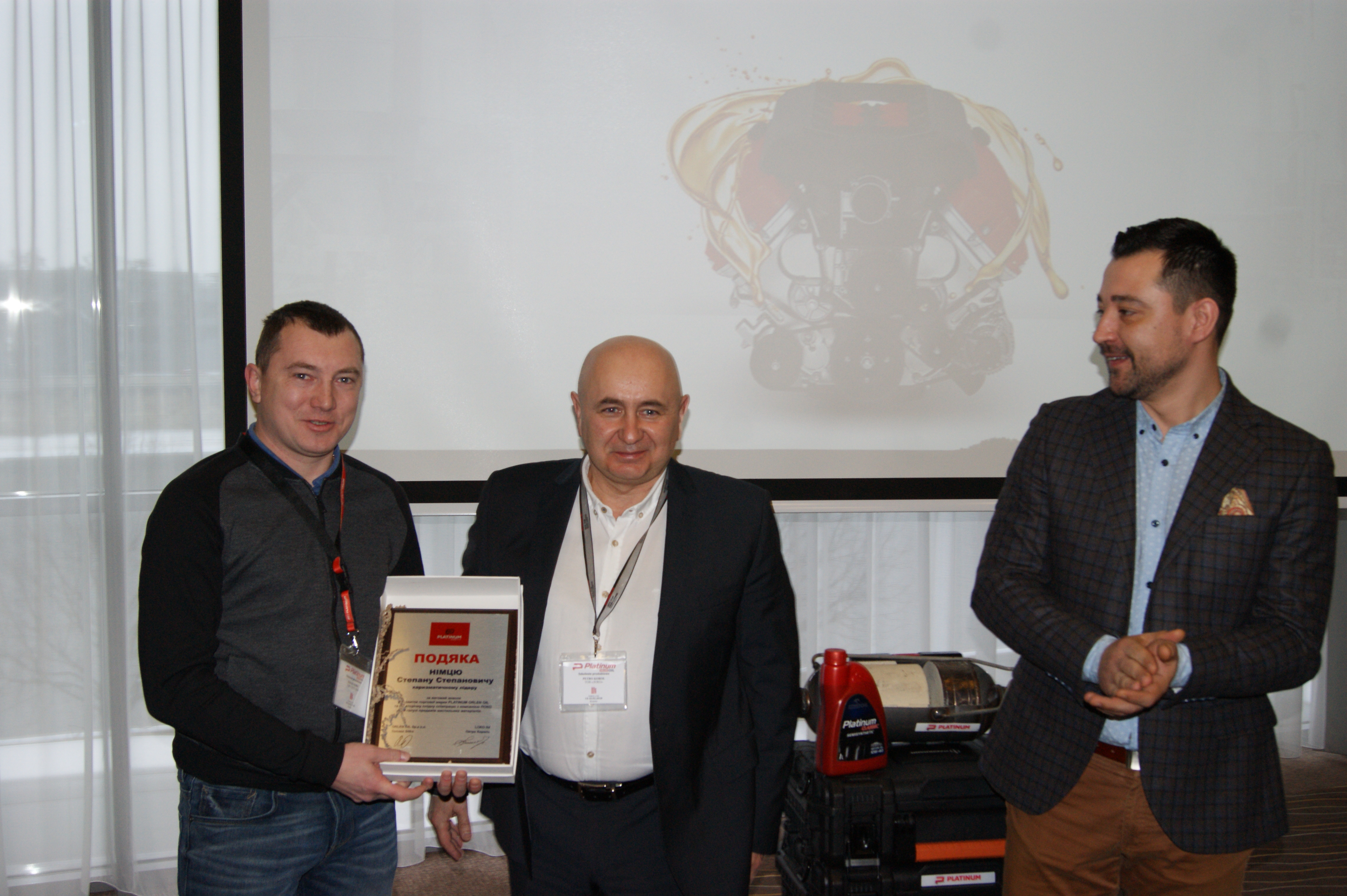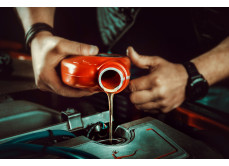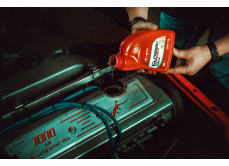1
Last news
Show by period:
- All news
- Last month
- Last 3 months
- Last 6 months
- Last year
The heat and the sun can not only give you a perfect, or not quite, tan. They can also do mischief. This is especially true for those who spend a lot of time at the wheel in the summer.
So save yourself so as not to lose:
1. When parking, leave your car in the shade if possible.
2. Even after a short stall, it is necessary to ventilate the cabin and only then start the movement.
3.
It is necessary to have in the car a minimum amount of drugs that you
use as a rule, and also necessarily - a supply of water.
4. With the slightest deterioration of well-being you must necessarily lower your speed and stop.
5. Try not to exceed the speed and increase the distance to vehicles that are moving in front.
6.
If you need to stop, then you need to slow down the speed gradually,
because with sharp abrasion on a hot asphalt the car can be put.
"How do you feel about a car, so it serves in response" - the truth has long been known and verified in practice. We offer to learn more ... much more about what they are - rules of operation and car maintenance in the summer season!
1. Regular washing
Yes, so, wash the car in the summer often! Now
there is no salt and no dirt, as in winter, but there are bird
droppings, spatula, splashes of bitumen, dirt, dust, juice from lime. All these contaminants can damage paint and varnish coating. Even
if they are chemically inactive and do not corrode it, at least the
paint can burn out unevenly and the machine is covered with stains.
How often should you wash your car? At least once or twice a week, "wash the dirt" and once a month, a full wash.
2. Avoid poplar
Poplar fluff, heat, July ... Fluffy poplar sedimentation highlights sticky yellow resin, which is very difficult to wash. In addition, he clogs the heatsink and worsens the cooling of the motor.
3. Replace the filters
Namely the air filter of the engine and salon. In the summer, a lot of dust and they quickly clog up. Lack
of air can cause incorrect operation of the engine, and in the cabin
will not be sufficiently good to cool the air conditioner.
4. Hide from the sun
If
you leave the car for several hours under the scorching sun, then you
can come back to see the plastic trim of the cabin, which has already
changed the shape. And the electronics may refuse to overheat. So
try to leave the car in the shade, but rather buy a cover - and the car
does not overheat and will have additional protection of the body from
the same litter, down and lime.
5. Cool to the extent
Use air conditioning moderately. Do not do in the cabin North Pole, when on the street Sahara. It is harmful to your health. In
addition, the air conditioner - an additional load for the engine, with
it he quickly heats up in traffic, it will be worse to pull and
gasoline will eat more. The climate system before the season should be served and cleaned - so that there were no unpleasant odors.
6. Do not fill the full tank
Some even advise to fill it no more than 50%. We believe that it is optimally about 3/4 capacity. The fact is that on the heat the fuel expands, can leak and even flare up.
7. Battery
The heat has a very negative effect on its resource. Control the electrolyte level and, if necessary, pour distilled water.
8. Tires
More often control the pressure, worn tires can even explode. This
will require a combination of high temperatures, which leads to
increased pressure and impact, which on our roads for a long time to
look for is not necessary.
9. Brake
Actual especially if you are moving on mountain roads. The mechanisms themselves (discs, pads) can overheat, they can boil the brake fluid. To avoid this, do not turn off the clutch in the descents (use engine braking). And the liquid should be changed if it is already 2 years or more.
First of all, it is necessary to determine which type of engine. If the 2-stroke is, of course, an oil for 2-stroke engines. Such oil is mixed with fuel and therefore burns, usually red or green. The
bright color of such oils is provided in order not to mislead it with
ordinary motor oil and visually estimate the mixing with fuel. According to the API classification (American Institute of Oil) and
JASO (Japanese Automobile Association), the oil should be selected
depending on engine volume and oil quality (Table 1)
A slightly different situation with 4-stroke engines. First of all, you need to realize that, for today, oils for motorcycles and cars for automobiles are virtually different oils. Due
to different operating conditions, in particular the speed of a
motorcycle engine, the engine's temperature is much higher, and the
physico-chemical properties of the oil, such as resistance to the cut,
temperature stability, are different. Modern
motorcycle oils are selected not only because of the quality class
(API, JASO) and viscosity grade (SAE), but also on the type of vehicle
itself (tourist, chopper, croaker or sports motorcycle). The engine manufacturer's recommendation is also extremely important.
A
striking example of such oils is the progressive oil brand for
motorcycles PLATINUM RIDER, manufactured under the new original High
Temperature Stability formula. Verified not only by ordinary consumers, but also on different types of competitions, in extreme conditions such as DAKKAR.
Yes,
this is absolutely normal, because the quality oil should neutralize
the products of decomposition in the engine after combustion of fuel. After
all, it is the products of decay, which may be sulfur, soot, tar,
varnish, various acids depending on the type of fuel, significantly
affect the color of motor oil during operation. It is necessary to worry when the color does not change during long-term operation. This may be a sign of a low alkaline amount of oil which is commonly referred to as washing the number of people. In the certificate or in the catalog for oil it should be indicated. It is desirable that for petrol and gas engines it was from 6.5 to 11 mgKON / g and 7-14 for diesel engines. 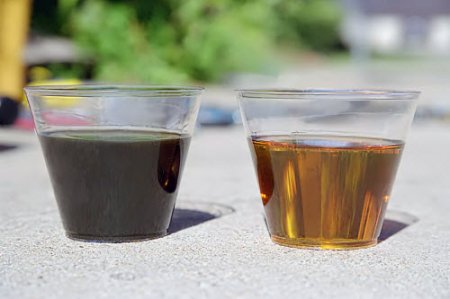 The darkening of the oil within reasonable limits should not be feared. A
similar situation requires washing dirty hands, using an alkaline
solution (for example, soap), we see contaminated water, but clean
hands. Similarly, with oil in the engine, it will darken, but the engine will remain clean.
The darkening of the oil within reasonable limits should not be feared. A
similar situation requires washing dirty hands, using an alkaline
solution (for example, soap), we see contaminated water, but clean
hands. Similarly, with oil in the engine, it will darken, but the engine will remain clean.
Spring has come, and with it and time is garden works. When cutting a tree to a modern person it is already hard to do without garden machinery, (petrol, and electric saws). In this article, we will talk about the oil that needs to be used in this technique and how important it plays.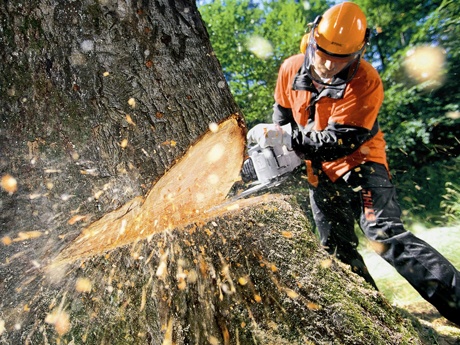
As you know, the chainsaw has a two-stroke internal combustion engine. There is no direct supply of oil in it, therefore the fuel-oil mixture is used. The main proportion of mixing is 1:50, at least 1:40. When
choosing an oil, it is necessary to be guided exclusively by the
requirements of the manufacturer of chainsaws, as well as the
specifications of the oil itself. It is for the chainsaw that there are no specially designed tolerances, however, there is for two-stroke engines in general. For example, API TC + JASO FC CEC TSC-3 ISO-L-EGD. (We will not dwell on the consideration of these specifications). In essence, the oil in the chainsaw performs a number of important functions, namely:
1. Excellent mixing with gasoline (special additive);
2.Antioxidative ability;
3. Anticorrosion function;
4.Transfer function;
5. Meaningful function.
Along
with these functions, the oil should have the lowest ash content, low
ability to smoke, and should also prevent coking of bypass and exhaust
systems. The oil should also have a low frosting point, for example, when working in the autumn-winter period. When working in the engine, the oil must prevent the spark plugs
contaminated, ensure the engine's cleanliness, reduce the wear of the
moving parts.
Orlen Oil Trawol 2T Olive Oil fulfills these requirements and
performs these functions, with properties you can find in our online
store.
Fuel and oil mixture should be stored for no more than two weeks! Since during long-term storage chemical reactions of oxidation occur, and volatile components of gasoline evaporate. All this in general can negatively affect the engine chainsaws. And the consumer in turn will blame the manufacturer of oil.
It is also important to lubricate the chain and sprockets on the tires. Many believe that you can use any oil for these purposes. We dare to disappoint you if you drank, not your neighbor, so do, not recommended.
The chain oil in the first place should reduce the temperature resulting from the friction of the chain and the tires. It should reduce the wear of the teeth, the parts and the steering tire. Also, this oil should have in its composition anticorrosive, antioxidant, anti-wear additive. It should have good sticky. All these qualities have a product that is presented in the LOKO assortment, namely: Pilarol (Z).
It
should also be remembered that after working with a saw, it is
necessary to lubricate the star on the tire with a special syringe, to
clean the tire from sawdust to clean the holes for the oil supply.
Now you can buy high quality KLEEN-FLO auto chemicals from Canada.
With the range of goods you can get acquainted on our website.
Almost everyone encounters this issue. Here the main thing is not to miss. Indeed, the weather this spring is variable. How to figure it out - when to go to the tire? Experts advise to change tires for summer, when the average daily temperature has exceeded the mark + 5-7 degrees. Previously dangerous, on the morning lake you can easily fly to the ditch. Later - stupid, on a dry and warm road, winter tires are more likely to wear out.
Winter rubber, unlike the summer, is softer. Already
at temperatures above +10 degrees winter tires start to work worse,
heat more warm under the rays of the sun and from warm asphalt, become
softer, the tread pattern is more likely to be erased. A studded rubber - not only that wears off the onset of warm weather,
the spikes on wet asphalt lengthen the braking distance and generally
make an uncomfortable trip on a dry road.
Of course, at the very best time in the tire repair shops - a boom. But it is better to enroll in advance or eventually defend the queue to the tire than to ride on rubber, inappropriate season. After all, no one in the head will have to walk in the spring in the boots. So why force a car to drive in winter tires?
In addition, if you are going to change tires for new ones - change everything right away. Do not follow the advice to change the tires only on drive wheels (front or rear, depending on the type of drive). The car, worn in a variety of types of tires, dramatically loses its sustainability on the road. And of course, change the tire if you notice the bloating on its surface, cuts through which the cord is visible.
Another
painful question - is it necessary to have a second set of disks in
order not to rearrange winter-summer tires every time on the same disks?
Experts leave it at the discretion of car owners. From overlapped rubber tires do not suffer. At the same time, having two sets of wheels with discs, you can save
on the services of tire carriers, independently rearranging tires in the
garage.
However,
after a couple of years, you will still have to go to the tire center
in the tire - tires tend not to last for more than two or three seasons
without losing consumer properties. So the savings will be scanty.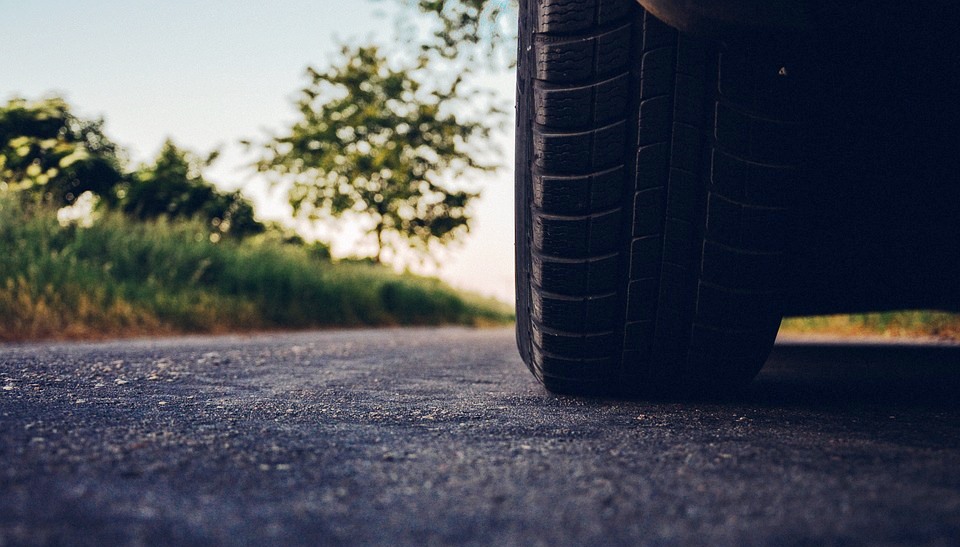
From which manufacturer to choose tires, solves each person, based on personal preferences and budget size. Undoubtedly, the quality of tires directly depends on their prices and used in the production of technology. But not always the most expensive rubber - the best. The difference in behavior on the road of different tires can be noticed only by a specialist.
The main ones are:
1) Effectively remove heat from the engine;
2) have a high boiling point;
3) Do not cause corrosion in the cooling system and also protect it from corrosion;
4) Have a low freezing point;
5) Mother has the maximum length of use.
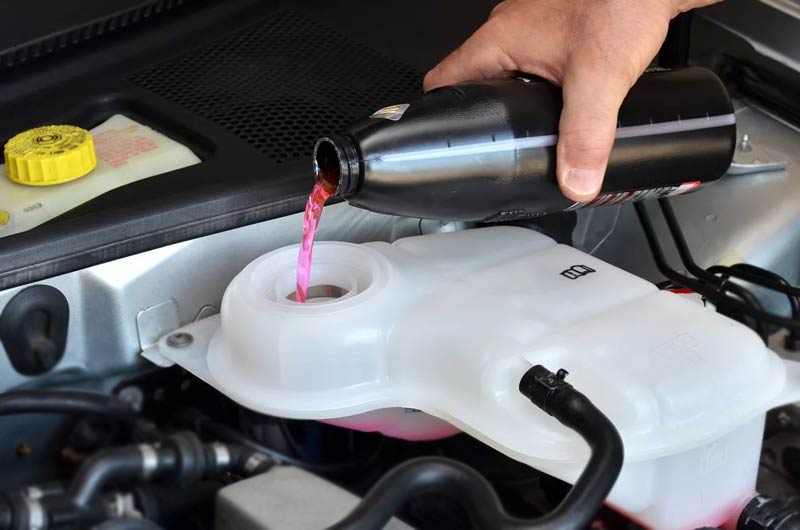
First of all, we want to emphasize that to determine the quality of antifreeze necessarily need to do laboratory research, but still some parameters can be estimated by simple visual methods, in particular:
1) If the cooling liquid with intense shaking is foaming and the foam does not settle for a long time, then forget about such a liquid, in case you have a modern car with high engine operating temperatures. Such a liquid is suitable only for older types of cars with low operating temperatures.
2) We can obtain data on the boiling and crystallization temperature only from the quality certificate on the product, but since the boiling point depends on the crystallization temperature, you should not expect that at the declared temperature of crystallization -650C you will have a boiling point of 1000C. As a rule, at a freezing point, most likely the boiling temperature will be no more than 850C. Due to the fact that the overwhelming majority of modern liquids consists of two main constituents of MEG, which freezes at a temperature of -12-150C and water with a crystallization temperature of 0 ° C, only with the proper proportions the parameters of the finished liquid can be applied to the desired temperature regimes.
We want to remind that Antifreeze is an international name for cooling liquids for engine cooling systems, and Tosol is a trademark of non-freezing coolant (antifreeze) developed in the USSR.
An optimum liquid for our conditions is a coolant with a temperature of crystallization of -350C and, correspondingly, a boiling point of 107-1080C.
Remember that if you prefer toastolium with a lower temperature of crystallization, you risk to get a low boiling point, which can have lethargic effects on your engine engine.
3) In order that the liquid does not cause corrosion, it must have adequate alkaline storage (in the range of 7.5 to 10). Such a liquid will affect whether corrosion will develop or not.
4) Since the two main components of the cooling fluid form an alcoholic solution, and all the alcohols are known to form acid during heating, there is a need to apply additional enrichment supplements. The more they are - the "noblest". But all the alcohols are corrosive substances that, when heated, form extremely aggressive oxides. Therefore, if your car is equipped with a radiator made of aluminum alloys, the simplest antifreeze in a very short time will turn it into something similar to a macaroni rinse. High-quality antifreeze contains a clear inscription on the package that they are suitable for use in aluminum radiators. The manufacturer, as a rule, tries to emphasize this, because the preparation of such a liquid requires very valuable components.
Dear our motorists, when choosing a coolant always use the recommendations of the manufacturer, beware of fakes (always the most popular products are forging).
Remember: overcooling or overheating of the engine reduces its motorcycle, leads to increased fuel and oil consumption.
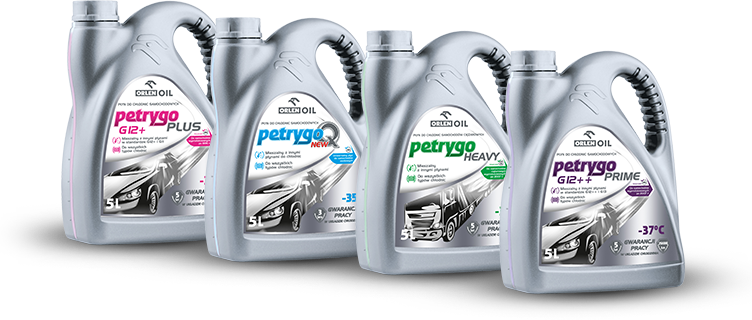
The viscosity of engine oil is currently determined by the SAE specification. The Society of Automotive Engineers, which means this abbreviation,
has developed an international classification, which has become a common
standard in most countries of the world.
The marking of motor oils by SAE regulates their viscosity. All world manufacturers of motor oils indicate in their products the designation in accordance with this classification. Let's try to figure it out.
Classification of motor oils by SAE
Most car owners distinguish between winter, all-season and summer motor oil. SAE
provides an understanding of their features in their specification,
where each grade of viscosity has particular significance. The classification of motor oils contains 5 summer and 6 winter classes of oils. The letter "W" in the designation means "use during the winter".
With the increase in the viscosity of the oil, the number that describes its class increases.
Specification of SAE motor oils characterizes only their viscosity-temperature properties, divided by season of use.
Classification of motor oils by SAE provides for all-season types of designation of the winter and summer viscosity parameters. As, for example, in 5W-30: the viscosity parameter for the cold season
is reflected to the left with the index "W", and for the demo-loop
cycle - in the right only figures.
The viscosity of SAE winter grades of motor oil is defined from 0W to 25W in 5 steps increments. Summer classes with the same step are characterized by parameters 20-60.
Requirements of the SAE Specification to Motor Oils
Characteristics of motor oils for SAE is determined by four main indicators: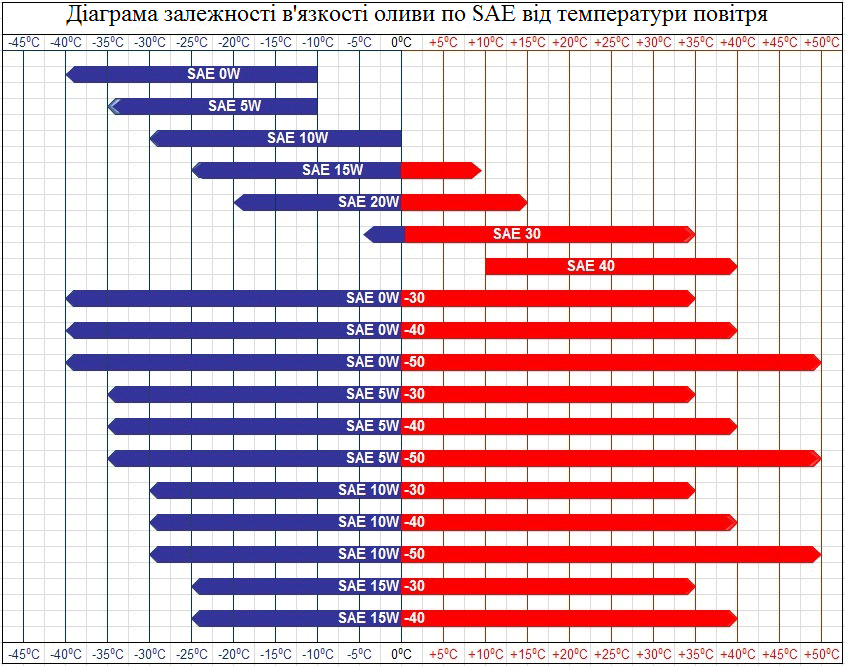
1. Viscosity in the operating mode of ICE.
2. Kinematic viscosity.
3. Starting properties.
4. Propellation.
The first indicator indicates the actual viscosity of the oil on the heated engine. He characterizes the ability of oil to resist:
1. wear of the piston group;
2. losses in the interaction of pairs;
3. temperature fluctuations when heating internal combustion engines when changing modes.
Taken together, the viscosity of motor oil determines the fuel consumption of ICE of any type. Other parameters will be more interesting to engineers than car owners.
When choosing the grade of viscosity of engine oil, refer to the manufacturer's recommendations. If your transport is used and there is no service book, then use simple selection rules:
1. When choosing winter oil, estimate the average winter temperatures in the area where you live. Select the viscosity class on the table based on these values to ensure easy startup.
2. Try to use all-season variants of oils with indices from 0W30 to 10W-40 in a mild, moderately continental climate. The viscosity of the engine oil of this class will be optimal when not hot summer and warm winter. Such a choice will allow you to quickly and easily start the
engine both in the cold and after long breaks in operation during the
spring-autumn cycle.
The
use of seasonal varieties is justified only in a sharply continental
climate and significantly increases the cost of changing the oil needed
at least twice a year.
When
operating a vehicle, engine oil gradually becomes dirty, aging, becomes
less viscous and loses its lubricating and protective properties. And it threatens the increased wear of all engine parts.
Motor oil performs a truly unique role in the work of the entire vehicle. Let's consider what this role is.
Functions of engine oil:
Motor oil lubricates all the parts of the automobile engine, which are in constant friction. Since the engine has a small number of bearings of rotation, the main load falls on the bearings of sliding. And if the oil loses its properties, then it starts to do worse for its work.
The oil is, in essence, an engine cooling system. It takes away excessive heat from friction, which increases the possible time of their operation. Some cars even have special radiators to cool the oil so that it performs this function as best as possible.
The oil provides cleaning of the automobile engine and all its parts from the scum and soot. That is why qualitative oil quickly darkens, which indicates its good cleaning properties. Someone may say that good oil should not change its color, but in fact - on the contrary.
The oil forms a protective layer on the walls of the automobile engine, which prevents its wear during start-up. Also, this layer serves as an anticorrosive coating and protects the engine parts with a long, simple vehicle.
If there is an old engine oil in the car's systems, then the vehicle will not travel long and will break very fast. Why is this happening? Replacing the engine oil, carried out untimely, can cause the strong deterioration of the main automobile unit - its engine. This, in turn, provokes a decrease in its performance, and in the future - a breakdown. Engine failure is a considerable financial expense. So, if the oil is heavily dirty or insufficient, be sure to complete the procedure for its complete replacement.
Thus, motor oil plays an important role in the operation of the vehicle. It
is therefore extremely important for him to change and use exactly the
oil that is best suited for a specific car brand in a timely manner. And remember, the foolish economy of motor oil can cause a lot of waste.
On January, 6 an anniversary 40th rally-raid started "Dakar".

The most extreme race of planet passed on territory of three countries : Peru, Bolivia and Argentina. Багатоденка founded French Тьєррі Сабіном, in 10th times in succession passed in South America.
on January, 20 a final race took place in that victory in the class of внедорожников was won a by Carlos Сайнс. And the honoured fifth place was got by a command Orlen Team at the head with Cuba of Пшигонським.
We congratulate a command!
www.youtube.com/watch?time_continue=45&v=0jTf_dS_AB4
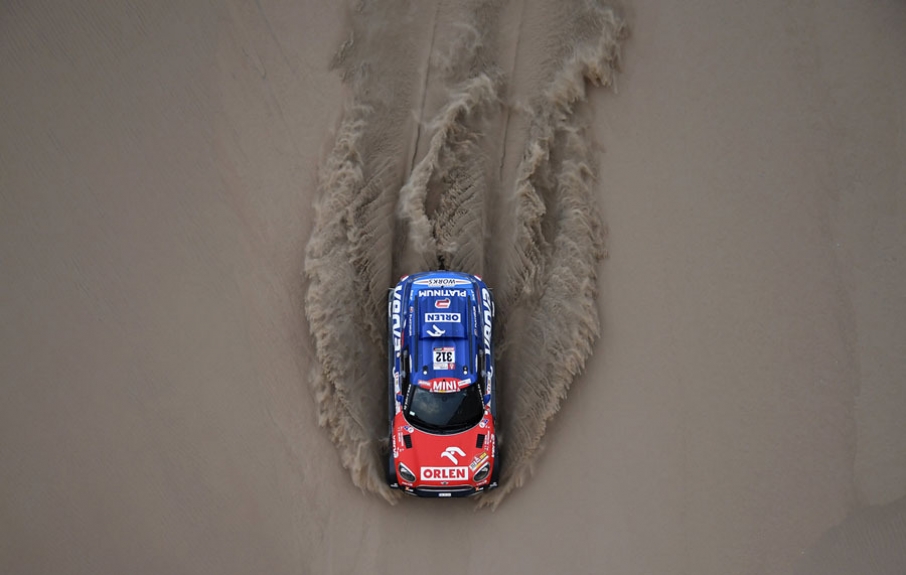
1. Speed.
Depending on the condition of the road surface and the presence of precipitation on the road, it is necessary to correctly assess the adhesion of the wheels of the car with the road and choose the appropriate speed. Experienced drivers recommend in the winter time to reduce the maximum speed by two to three times. In the winter, you should always remember that at any moment, ice or wet snow may appear under the wheels. Dialing and resetting speed is always necessary smoothly.
2. Parking.
Leaving the car in the parking lot in winter, first, do not worry about parking brakes (can be tightened by brake pads). You can also put small plastic objects under the windscreen wipers so that the wipers' brushes do not touch the glass and do not freeze. It is recommended that the gaskets and trunk lid be dried dry, and even better soaked with special tools so that there is no difficulty with their opening. If you have to park the car in the snow, you should always leave a place with a stock, in case of a hitch, do not move to other objects in the immediate vicinity.
3. Turns
Walking the turns on the winter road is one of the most dangerous events. Throw speed before turning, while the wheels are straight. In the turn, you have to move on one transmission, without discharging and adding speed. It is possible to increase the speed only at the exit of the turn, and very smoothly. In turn, you always have to be ready for skidding under the action of centrifugal force. The only way to reduce the centrifugal force is to lower the speed before turning.
4. Morning procedures.
If your car slept on the street and snow was at night, do not be too lazy to completely clean the car from rain.
5. Braking.
Before winter braking, you must carefully assess the condition of the road surface. Even a clean road may appear to be covered with ice. When leaving the parking lot, you must try to slow down the safe area and evaluate the condition of the road. In winter it is better to give preference to inhibition of the engine (gradual transition from higher gear to the lower one) before using the braking system of the car.
6. Snowfall and fog
Moving in a strong fog, snowfall or it is recommended to drop the speed significantly, be sure to turn on the dipped beam headlights and "anti-fog". Overtaking in fog is not desirable. If visibility has sharply deteriorated, you need to slowly slow down and, having come to the roadside, stop. If it is at night, it is recommended to place an emergency stop sign so that a parked car can be seen. The reason for stopping may be fog with visibility less than 50 meters.
7. The road is frozen
On a glacier road it is recommended to move very slowly. It is necessary to remember that on a slippery road the braking distance increases by 2-3 times and more. It is also necessary to avoid getting into even small ice tracks, the exit from which can end up loading and demolishing from the road. Short straight areas of the frozen road need to be overcome with the included gear and with no sudden turns of the steering wheel, using the maximum using the inertia of the car.
8. In the snow in the city.
Public utilities are not prepared in time for the winter, so you can get into the snow captivity in the metropolis. Most often in the snowfall it is faster to get from point A to point B on a certain public transport. If you decided to go by car, do not hurry to go. Keep distance!
9. Strong frost.
The main problem of a motorist in a severe frost is the start of the engine. You need to keep track of the weather forecasts. If weather forecasters promise -25 or below, it makes sense to remove the battery (if it's already old) and put it in a warm room to reduce the loss of its capacity. In the frost, a little warm up the engine and transmission, more to the automatic transmission (on the "machine" American machines even have a lamp-indicator of temperature and readiness for operation). Also, it will not be unnecessary and will prototype the salon, so that from the windows came inya. It should be remembered that it is not recommended to direct air ducts with hot air directly to the glass. Sharp temperature variations can lead to cracks (fortunately, this happens extremely rarely).
If the wheel is lowered or punched?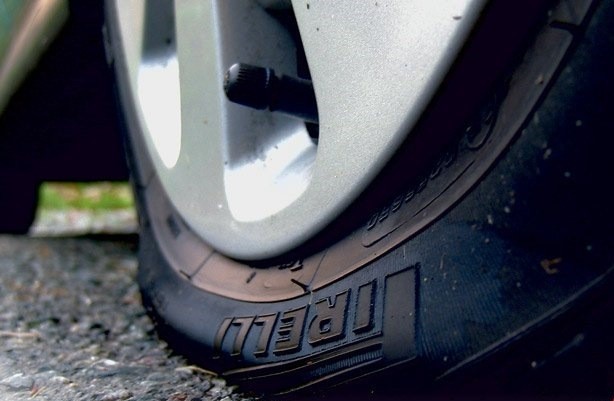
If you find a lowered wheel, then the first thing to try to pump it with the help of a car compressor for tires. It is desirable to have these devices for every motorist, because they
will help to pump the wheel when there is no help or far from
civilization (in the village or on a deserted route), and their cost is
small.
When the car wheel is pumped, listen to the sounds that come out of the wheel. If the wheel is pierced or there is a cut, then you can hear a whistle from the bus. Also, a clear sign is the pressure drop in the tire, after being pumped to the nominal. Verdict: when the tire goes down very quickly and it is impossible to
continue the movement - this is either a replacement for a spare wheel
or to get to the nearest car service.
And if you imagine that the two wheels are pierced, for example on the right side of the car. What to do then?
First of all, it comes to mind - to evacuate. It can always be done, there would be a mobile phone with you. But remember, if the situation occurred outside the city, the call of the tow truck will cost you a fair amount.
How much can you drive on the lowered wheel?
The main thing to go carefully and slowly. This is a risk because you can damage the car's suspension details. And also the wheel itself, and if you have original tires and discs, then moving on the wheel is extremely dangerous. Possible major damage to the tire and disk, which will lead to their complete replacement.
Let's summarize, if you go to the tire not far, you can get yourself. If
you are far from civilization and is not near the car service, it is
worth filling the tire with scraps and getting to the place of repair. Also, do not forget about third-party assistance, such as the call evacuator, or the mutual assistance of drivers.







